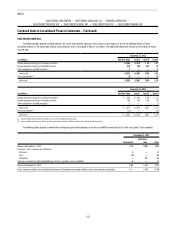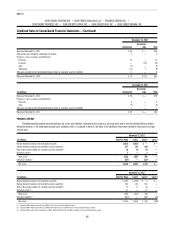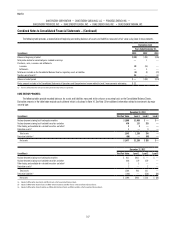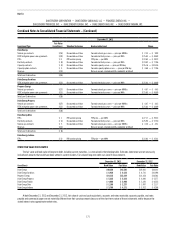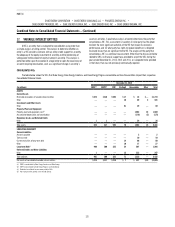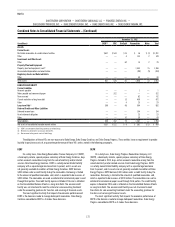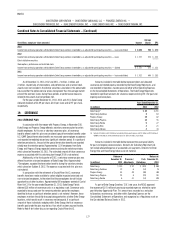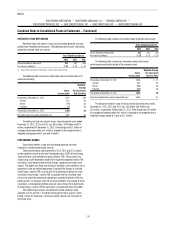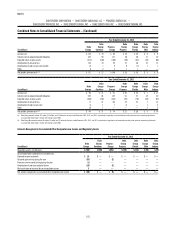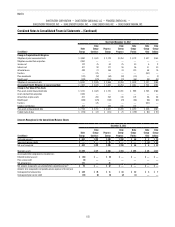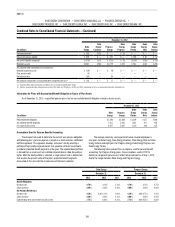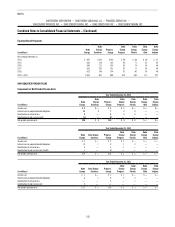Duke Energy 2013 Annual Report Download - page 193
Download and view the complete annual report
Please find page 193 of the 2013 Duke Energy annual report below. You can navigate through the pages in the report by either clicking on the pages listed below, or by using the keyword search tool below to find specific information within the annual report.
175
PART II
DUKE ENERGY CORPORATION • DUKE ENERGY CAROLINAS, LLC • PROGRESS ENERGY, INC. •
DUKE ENERGY PROGRESS, INC. • DUKE ENERGY FLORIDA, INC. • DUKE ENERGY OHIO, INC. • DUKE ENERGY INDIANA, INC.
Combined Notes to Consolidated Financial Statements – (Continued)
December 31, 2012
Duke Energy
(in millions) DukeNet Renewables
FPC
Capital I
Trust(c) Other Total
Duke
Energy
Ohio(a)
Duke
Energy
Indiana(b)
Receivables $ — $ — $ — $ — $ — $ 97 $116
Investments in equity method unconsolidated affiliates 118 147 — 27 292 — —
Intangibles — — — 104 104 104 —
Investments and other assets — — 9 2 11 —
Total assets 118 147 9 133 407 201 116
Other current liabilities — — — 3 3 — —
Deferred credits and other liabilities — — 319 17 336 — —
Total liabilities — — 319 20 339 — —
Net assets (liabilities) $ 118 $147 $ (310) $ 113 $ 68 $201 $116
(a) Reflects OVEC and retained interest in CRC.
(b) Reflects retained interest in CRC.
(c) The entire balance of Investments and other assets and $274 million of the Deferred Credits and Other Liabilities balance applies to Progress Energy.
The Duke Energy Registrants are not aware of any situations where the
maximum exposure to loss significantly exceeds the carrying values shown
above except for the power purchase agreement with the Ohio Valley Electric
Corporation (OVEC), which is discussed below, and various guarantees,
reflected in the table above as Deferred credits and other liabilities.
DukeNet
Until December 31, 2013, Duke Energy owned a 50 percent ownership
interest in DukeNet. DukeNet was considered a VIE because it has entered
into certain contractual arrangements that provide it with additional forms of
subordinated financial support. The most significant activities that impacted
DukeNet’s economic performance relate to its business development and fiber
optic capacity marketing and management activities. The power to direct these
activities was jointly and equally shared by Duke Energy and the other joint
venture partner.
On December 31, 2013, Duke Energy completed the sale of its ownership
interest in DukeNet to Time Warner Cable, Inc. For more information on the sale
of DukeNet, refer to Note 12.
Renewables
Duke Energy has investments in various renewable energy project entities.
Some of these entities are VIEs due to power purchase agreements with terms
that approximate the expected life of the project. These fixed price agreements
effectively transfer commodity price risk to the buyer of the power. Duke Energy
does not consolidate these VIEs because power to direct and control key
activities is shared jointly by Duke Energy and other owners.
FPC Capital I Trust
At December 31, 2012, Progress Energy had variable interests in the
FPC Capital I Trust (the Trust). The Trust, a finance subsidiary, was established
for the sole purpose of issuing $300 million of 7.10% Cumulative QUIPS due
2039, and using the proceeds thereof to purchase $300 million of 7.10% Junior
Subordinated Deferrable Interest Notes due 2039 from Florida Progress Funding
Corporation (Funding Corp.). Funding Corp. was formed for the sole purpose of
providing financing to Duke Energy Florida. On February 1, 2013, Duke Energy
redeemed the QUIPS and subsequently terminated the Trust.
Other
The most significant of the Other non-consolidated VIEs is Duke Energy
Ohio’s 9 percent ownership interest in OVEC. Through its ownership interest
in OVEC, Duke Energy Ohio has a contractual arrangement to buy power from
OVEC’s power plants through June 2040. Proceeds from the sale of power
by OVEC to its power purchase agreement counterparties are designed to be
sufficient to meet its operating expenses, fixed costs, debt amortization and,
interest expense, as well as earn a return on equity. Accordingly, the value
of this contract is subject to variability due to fluctuations in power prices
and changes in OVEC’s costs of business, including costs associated with its
2,256 MW of coal-fired generation capacity. As discussed in Note 5, proposed
environmental rulemaking could increase the costs of OVEC, which would be
passed through to Duke Energy Ohio. The initial carrying value of this contract
was recorded as an intangible asset when Duke Energy acquired Cinergy in April
2006. This amount is included in the table above for Duke Energy and Duke
Energy Ohio.
In addition, Duke Energy has guaranteed performance of certain entities in
which it no longer has an equity interest.
CRC
See discussion under Consolidated VIEs for additional information related
to CRC.
The subordinated notes held by Duke Energy Ohio and Duke Energy
Indiana are stated at fair value and are classified within Receivables in
their Consolidated Balance Sheets. Carrying values of retained interests are
determined by allocating carrying value of the receivables between assets sold
and interests retained based on relative fair value. The allocated basis of the
subordinated notes are not materially different than their face value because
(i) the receivables generally turnover in less than two months, (ii) credit losses are
reasonably predictable due to the broad customer base and lack of significant
concentration, and (iii) the equity in CRC is subordinate to all retained interests
and thus would absorb losses first. The hypothetical effect on fair value of the
retained interests assuming both a 10 percent and a 20 percent unfavorable
variation in credit losses or discount rates is not material due to the short
turnover of receivables and historically low credit loss history. Interest accrues
to Duke Energy Ohio and Duke Energy Indiana on the retained interests using the
acceptable yield method. This method generally approximates the stated rate


